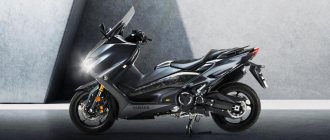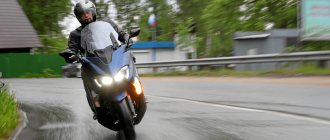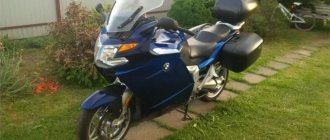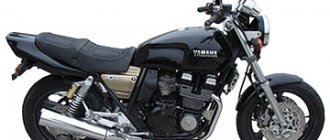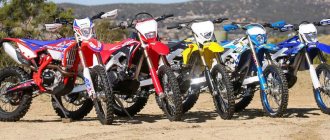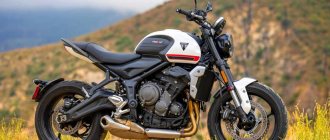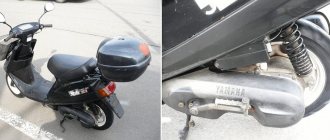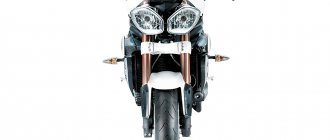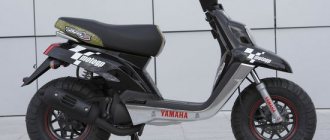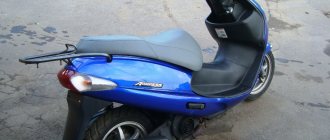Motorcycle journalists around the world are excitedly discussing the “knight’s move” that BMW made. They say that the Bavarians struck at their competitors on the sly, invaded someone else's territory, departed from traditions... And for some reason no one remembers that back in 1999 the concern had already tried to stake out a plot for itself with the motorcycle-like scooter C1. This expensive project was a fiasco - the scooter with a roof was produced for only a few years. Most likely, in those days, society was simply not ready for such a “presentation of material.”
Now the situation is different: scooters have increased in volume (both motor and body) and are equipped with rich equipment. It's time for BMW to make a statement again. Back in 2008, sketches appeared online, and last year they showed an electric prototype. But in the end they settled on a traditional gasoline engine, since the company already had a suitable one in its arsenal. The parallel “two” with a volume of 650 cc fits optimally into the chassis of a maxi-scooter.
In general, BMW marketers decided to kill a couple of birds with one stone. Two variants are presented on one base: C 600 Sport and C 650 GT. But if the first one is quite traditional for this class, then the hero of our test can be called a miniature motorcycle with an automatic transmission, and made in the corporate style of tourist BMWs.
The developers did not skimp on the equipment: the stock features an electrically adjustable windshield height, heated steering wheel grips and both seats, ABS brakes, plus a side stand that functions as a parking brake. The last one is simply brilliant! Why didn’t they think of such a solution earlier?
I've ridden all scooters in this class, but I've never seen a riding position like the GT's anywhere else. It is better to throw your legs far forward, the sacrum rests against the rear bolster of the seat, and your arms are extended as far as possible to reach the steering wheel. Well, just an American chopper, and tuned to the point of loss of pulse! But such ergonomics encourage relaxation behind the wheel - you want to drive sedately, like in a limousine.
However, you won’t be able to light it on a scooter. The CVT setup is downright boring, and acceleration, no matter how hard you turn the throttle, is smooth and measured. Confident though. Either the considerable weight of the car (261 kg) is affecting it, or there won’t be enough horses in the engine (60 hp). The exhaust sound is even more disappointing: something buzzes, as if through a pillow. The “greens” will be happy, but the future owner will probably first decide to install the optional Acrapovic forward flow. True, to the detriment of appearance, since the standard “barrel” is harmoniously integrated into the fairing. However, it's not all bad.
DRIVE UNIT
Instead of a belt, the variator has a chain.
Matches the loads from a large engine. Uniform acceleration and excellent wind protection (with the window raised to the maximum, you can probably even smoke while driving) hide the sensation of speed from the driver. On a suburban highway, without knowing it, I accelerated to a fantastic speed by scooter standards - 180 km/h according to the speedometer! Even the vaunted Yamaha TMAX did not reach such limits.
I, not believing my eyes, tried to squeeze even more out of the car, lying on the dashboard. A police patrol brought me back to reality (and quite quickly). For some reason, the guys were not interested in testing such an unusual BMW, and a considerable fine sobered up your humble servant, thoroughly biting his credit card.
But let's not talk about the sad things... There are clearly more positive things. The device steers obediently, accurately and even sharply. Almost like a motorcycle. At the same time, the force required to enter a turn is small, and the scooter stands perfectly on the trajectory. This is due to the rather tightly built, energy-consuming chassis and 15-inch wheels with good Metzeler Feelfree asphalt tires. At the exit from the bend, when gas is added, the device straightens itself and goes onto a straight trajectory, from which even a strong side wind does not move it. Moreover, driving around the city and even in traffic jams does not bother the driver.
Hello! I live in Warsaw. In this post, I will talk about the 2021 BMW C650GT I drove it 11,000 km. in a year and a half. Well, a little about Poland.
Background: How it all started: - the first motorcycle, Yamaha Tricker 250 cm. 3 (year and 5,000 km), - Kawasaki Versys 650 (owned for a year and a half and 20,000 km), - there are trip reports in my profile, - Honda CBF 1000 ( six months and 15,000 km), - similarly, see reports in the profile, - Triumph Rocket III 2,300 cm3 (four months, 10,000 km), - I wanted to write about it, but I never got around to it. — BMW S1000XR (six months and about ten).
I rode motorcycles around Moscow from April to November (and was very bored in the winter), plus each season I was able to take 1-2 long trips.
The farthest distances were to Lofoten, Norway - it’s about 7 thousand km. (a report in four parts is on my profile) and to Antalya - 8 t.km. But it turned out to be possible to travel less often than we would like, and the main time of movement was reduced to daily crawling through traffic jams in the work-home mode, about 40 km. both ways, every day. On a motorcycle. Moscow (with its show-offs) naturally leaves its mark on the way of thinking and the evolution of you as a motorcyclist. Scooter riders here are treated like second-class citizens, they are not welcomed - in fact, they are not welcomed anywhere :) well, except for maxi scooters, they joke about airing between the legs, etc. There are a lot of expensive new motorcycles. There is no such concentration of new geese, golds and Harleys in any other European country. Everything is exactly the same as with expensive cars. This philosophy corrupts, makes you constantly want more and greatly distracts you from simple and convenient things. Each of your new motorcycles simply had to be more powerful, more expensive, faster. I once accelerated to 235 km/h in a BMW S1000XR. And I thought to myself: listen, where, exactly, is the limit? Why such power at all? Neither for a long trip, nor for the city, you need neither 160 horses, nor a maximum speed of 250 km/h, as on the “Khryun”, nor an engine capacity of 2.3 liters and 170 nm of torque of the mammoth Rocket. This includes increased consumption, weight, and handling. And constant clutch work in traffic jams. Did you depress the clutch on the Rocket?) A year before moving to Warsaw, my family and I went to Corfu, and I “remembered my youth” - I rented a Piaggio 200 cm3 scooter, one cylinder, and was pleasantly surprised at how easy it was to control and drives briskly. I have always been attracted to scooters for their practicality and ease of use. Once upon a time, with a scooter, 125, after Vietnam (and 10 years ago - Thailand), the passion for motorcycles actually began: motorcycle school, the first “check”, and so on. It was then, so to speak, that my eyes became blurry. The motorcycle instructor, when I asked what kind of motorcycle to buy (“manual” or “automatic”? - ha-ha), said: well, of course, a motorcycle, not a scooter! But I wanted it automatically, and I sincerely didn’t understand why not? After all, no one buys a car with a manual transmission now? It's inconvenient. But it was a long time ago:)
By the time I moved to Poland, I had sold Hryunya and was looking for a new motorcycle, already here in Warsaw. I thought, out of inertia, about a motorcycle, but assumed that I would buy a scooter, that is, a maxi-scooter. Essentially the same motorcycle, but with a CVT.
A test drive R1200RR with a mileage of 8,000 km was sold at a BMW showroom. I took it for a ride and didn't like it. It blows from everywhere, low. Not mine. I wanted something new that had not existed before. It started raining heavily when I was testing it. And at a traffic light, old Burgman unexpectedly easily “made” me). It's not like that, guys.
There was a C650GT standing next to the bay window in the salon. Also formally used, but with only 500 km mileage from last year. The previous owner bought it new from the same official dealer, and after driving it for a week, he traded it in. Price: about 900 tr. in rubles at that time. I sat and liked it. Bought. I haven’t read the reviews, but I heard from a couple of friends that it seems to be fast. Well, let's try. The dynamics are very decent. It would seem that there are only 60 horses and an in-line 2-cylinder engine, what can you expect? Official statistics are about 7 seconds to a hundred. BUT! A scooter shoots out from a traffic light. The light turns green and you just twist the throttle. In the range from 0-60 km/h, it is almost no exaggeration to say that it has no equal in gaining speed. The 600s will definitely remain behind in this range. It's all about the variator. While the motorcycle puts in first gear, spins up, then second, a lot of time will pass and the BMW will pull ahead. A little later, sports will catch up with you, of course. There is also a surprise factor. Other motorcyclists at a traffic light don’t expect the scooter to take off so quickly from the very beginning, and plus, not everyone likes to rev the engine to death at first. And if you don’t spin it like that, from the very beginning, on a motorcycle, then you’ll make a GT.) I repeat, this only applies to acceleration to 60-70 mph. Well, liters are faster, of course, but also in different ways. In general, a very worthy start. After 70 km/h the dynamics fade a little compared to a motorcycle. But still, I think the acceleration is very decent. In any case, across the entire range of available speed, power and dynamics of the GT, there is enough to feel confident both in the city and on the highway. The maximum speed is limited to 180 km/h. electronics. I accelerated to this speed many times, the speedometer needle rests on the 180 mark and that’s it. The acceleration stops, and the car no longer goes a kilometer faster. Cruising speed - 140-150 km/h. The 150 can be driven for many hours on a good road. The comfortable feeling continues up to 160 km/h. The last 20 km/h 170-180 km/h is already slower, it starts to wobble. Actually, this is also true on ordinary motorcycles; it’s not so much a question of the engine as of aerodynamics. The sound is fabulous, a little choppy, good standard exhaust. You want to turn the engine and turn it. Fuel consumption: in the city about 5-6 liters per hundred, on the highway at a speed of 140-150 it increases to 7-7.5 liters. The tank is located, just like on motorcycles, between the legs, but does not stick out and is not visible. There are 16 liters of 95 gasoline. It lasts for exactly 200 km when driving on the highway. There is probably some small reserve left. I drove (what felt like) 230 km on the last gas fumes, when the road was being repaired near Piotrkow-Trybunalski and there were no gas stations for a long time. After the fuel indicator lights up, the on-board computer begins to show the number of kilometers traveled on reserve. Twice in a year and a half I rode the Warsaw-Vienna-Warsaw route (700 km one way) to visit a friend. It's very comfortable to ride. Almost like Gold. There's a lot of plastic, which is great. The entire body is completely protected from dirt and water flying from the road. Even in heavy rain, you don’t have to wear shoe covers, your feet will be dry. All you need is a raincoat, of course. The suspension is moderately hard, moderately soft. The scooter is not for bad roads. Driving on uneven asphalt is normal - there is no washboard feeling. But of course, not a goose. You can also use primer or sand, carefully. Once I was looking for a shortcut to a lake in the forest and ended up in God knows where. I was too lazy to go back, and there was no road ahead. Somehow I drove by :) Capacity - the rear case is 44 liters or so, it can accommodate a modular helmet and small items. Two helmets will fit into the huge “toilet”: a full integral and another three-quarter helmet. Or two packs of water, 8 bottles x 1.5 liters. On the sides you can stuff little things, a raincoat, gloves, cobwebs. The tool set is attached with an elastic band to the seat and rises with it. There is a lot of space. The fit is moderately chopper and comfortable. There is no tank to hold onto with your knees. But you can choose the position of your legs: either put them down, like on a motorcycle, bending your knees at an angle of 90 degrees and straightening your back, or stretch your legs forward, almost completely, like on the footrests on a cruiser, and rest your butt against the back of the seat, and so Thus, on uneven roads the driver’s driving position will be very stable. My feet stand confidently on the ground (my height is 180 cm). The scooter (and according to the passport - it is a motorcycle) is heavy, but due to the low center of gravity it is very easy to shift, stow and steer well.
The seat is divided into two parts: for the pilot and the passenger. I sat my son (4 years old) in front of me, and we went everywhere with him: to kindergarten, shopping, and the farthest thing - to a water park 60 km from home. Convenient: both my and his feet are on the footrests. The pilot's seat is only slightly short enough for two, and my son slid forward a little when braking. Not critical. At traffic lights I pulled closer. One day he fell asleep during a long trip. But the child sits in front of you, you hug him, hold him with your legs, and control the position.
I specially adapted an airplane-type belt for these purposes and fastened it to myself.
In general, you can’t ride a motorcycle like that, the tank is in the way, plus there’s nowhere to put your feet except on the bars. There are more controls on a motorcycle, you need to stick the gears in with your left foot and operate the clutch with your left hand. By the way, in Poland, traffic regulations allow children to ride two-wheelers. Until the age of seven, there are speed restrictions - no more than 40 km/h. After reaching the age of seven, there are no restrictions. A matter of your own experience and careful driving. There are no or almost no tail-shooting radars in Poland. And the risk of being caught for speeding exists only insofar as there will be an unmarked police car behind you, or, in the old fashioned way, a traffic cop standing in ambush with a radar gun. Of course, I try to drive very carefully with a child. And now we only ride a 125 cm3 scooter. The BMW's brakes are confident, like those of a Honda. There are two discs at the front, one at the rear. Removing the front caliper to replace the pads is more difficult than, say, on the Versus. You can't just change the rear pads, you need to remove the wheel and unscrew the muffler. The scooter bites a little when braking - but within normal limits. There is no telelever. Traction control helped a lot a couple of times, abs too, all electronic systems work well. The dead zone sensor is a kind of recess in black plastic that can be seen on the left and right rear. At the moment when a car overtakes you and gets into the blind spot, where you can’t see it in the mirror, orange triangles light up in the area of the mirrors. I didn’t find this function particularly necessary; in my opinion, it distracts more from the road. Tire pressure sensor: always on the display, you can see how many atmospheres are inflated at the front and rear. Review of the mirrors are good, someone complained about them, but I had no complaints. Everything is perfectly visible. The windshield is wide, electrically adjustable with a button on the steering wheel. This is amazingly comfortable in the rain. In a traffic jam, you roll down the window and the entire road is clearly visible. If you pick up speed, you go up. In the highest position, the glass is approximately at eye level, quite enough to cut off the oncoming flow. The sofa is heated. There is separate heating for the pilot, turned on on the steering wheel, and for the passenger, turned on by a mechanical switch on the right side of the passenger seat. Two grill modes. Heated grips, of course, three modes. During the cold season, these two little things, together with excellent wind protection, help keep you warm. Among the inconveniences: the entire steering wheel is made of plastic. There is nowhere to screw the holder and hang the phone. I put it in the glove compartment and, when necessary, drove with the glove compartment open, looking at the navigation. I know that dealers offer special solutions, but they include some design changes to the steering wheel, are expensive and spoil the appearance. This is an obvious disadvantage. In terms of dimensions, unfortunately, the scooter is quite wide. Wide mirrors (the view is normal in them, by the way). Taking into account the fact that the lanes in Europe are narrower than those in Moscow, especially in the city center, sometimes it was necessary to move in the general flow of cars. In this regard, it is, of course, very inferior to fifty kopecks and 125 kopecks. Regular road bikes have an advantage over GTs here. They have a narrower steering wheel. February before last in Warsaw: February in Russia... But this year the winter here was about as snowy as in Moscow. And it’s still cool, +10 during the day, and now it’s already the second half of April. Summer still won't come. There were no breakdowns on this BMW. I think he's quite reliable. And the main drawback that many people don’t realize is the cost of maintenance. It’s simply cosmic , if you take the officials. But I found out about this only after the purchase))). I've only done two maintenances in all this time. The first at 1000 km, a week after purchase. I got it for free as a discount. The second maintenance at an official BMW dealer was scheduled at 10,000 km, and it cost 20,000 rubles, this is only an oil change and standard checks. The dealer told me that the BMW C650GT is the most expensive BMW motorcycle to maintain . Even more expensive than the dumbbell, K1600GTL. The most interesting thing in terms of prices begins with the increase in mileage. So, maintenance with a mileage of 20,000 km. costs 75 thousand rubles, and the most expensive maintenance is 30,000 km. It costs 150,000 rubles!!! This is when the price of a new scooter is a million. The service employee said so, it’s easier to sell and buy a new one. Therefore, look, there are many advertisements on the Internet for this scooter with very attractive prices, if you buy, ask whether the maintenance has been done, and look at the documents. You can go broke on maintenance. Well, either do it yourself, or have someone else do it, but I don’t know how to do it other than tighten and lubricate the chain, and there are no conditions. By the way, about the chain. This model has an interesting system, there is a chain (on the right side, it is naturally hidden) and a belt. The mechanic explained that BMW engineers made such a sophisticated system, supposedly to preserve torque and smoothly accelerate. Naturally, there is no need to lubricate or tighten anything; this is all done during maintenance. Well, on the secondary market the scooter loses a lot in price. The first owner bought a new one for 54,000 (1 million 100 tr.) zlotys, I bought it at this dealership with only 500 km on it. already for 44,000 zlotys (900 tr), and he sold it a year and a half later for only 36,000 zlotys (720 tr), with great difficulty. And I didn’t sell it, but exchanged it with my small surcharge for a Suzuki DL 1000 V-Strom. Why did you get rid of it? I’m not happy about the prospect of having to do expensive maintenance after every long trip. It’s not good that every year it will lose so much in value. And I just got fed up and wanted something new. Although the scooter is very worthy and solid. For the city, by that time I had two 125s: SYM and Honda. Well, a little more, for friends) They are much more convenient in traffic jams, stupidly lighter. Over time, you attach importance to these things. Someone said: “a compromise is always worse than any of the alternatives.” Therefore, there should be several units of equipment, for different purposes. This is the axis of motorcycle hobby. Motorcycle - for travel and pleasure, scooter 125 cm - ideal scooter power for the city - for everyday use. For groceries, for errands, for the Christmas tree, anywhere, I sat down, drove there, left it on the sidewalk, forgot. Driving in the snow is not so scary if it suddenly starts to snow. I fell on Sima a couple of times, due to small things, not as bad and not as expensive as repairing a motorcycle. Changing the oil - I took a can to drain it, went to a secluded place where no one was there, and changed it myself. 5 minutes business. I sold Sima, and I confidently use my Honda PES 125, 2008, with a mileage of 21,000 km every day. I don't have a car. I drive, but I don't really like boxes. She is not needed here. Parking, traffic jams, expensive insurance, etc. Uber is more than enough. The motorcycle scene in Poland is weak compared to Russia. The service is poorly developed. During the season there are long queues for repairs; everything takes a long time and is often of poor quality. Often on the principle of manana, as in Latin America. They greet each other somehow languidly on the road. And it certainly doesn’t happen that 10 volunteer Komsomol “motorcycle brothers” drove up to a motorcyclist who stopped on the side of the road to check his phone in 5 minutes and asked if everything was okay. They greet each other much less often. They communicate mainly with friends. Small talk on the highway, at a gas station or in a cafe with strangers, like “how are you, where are we going?” is also possible, but much less popular than at home. Poles are wary of strangers and do not engage in conversation without a special reason, although they will answer politely if you need to ask them something - these are disadvantages. But on the other hand, less bullshit, less aggression, more culture on the road and in life - these are advantages. No one really gets out of the car with a golf club :)) If we talk about motorcycle travel, a trip of 200 km, or a trip in winter if the air is below +10, is already considered a feat. For some Sunday gathering near Katowice or Lublin. Unfortunately, there is no such universal motorcycle culture as in Russia, the States or England. The equipment is mostly “dinosaurs”, although there are various motorcycles. Most often, if Poles buy a new motorcycle, it will be the “best compromise” in terms of price-quality ratio. For example, Yamaha Tracer 900. I’m looking forward to when the borders open and motorcycle friends from Russia will be able to come visit me, so that we can go on long journeys on motorcycles like in the good old days!
LANTERNS
Massive. LEDs create beautiful, noticeable patterns
The 650 GT starts off smoothly, steers clearly and slows down quite predictably. Although without ABS, it seems to me that there would be problems with the effectiveness of the rear brake. The “plumpness” of the GT is a little annoying - the dimensions in the mirrors are not at all scooter-like, and the rear part is plump. So cutting through the traffic flow like a snake is not so easy. There is only one rule: if the steering wheel and mirrors are clear, then you won’t hit anyone with your back.
What fate awaits the new recruit? I think it's stellar. Now the maxi sector is expanding very rapidly. Even in our country. Many office workers will want to get such a device - beautiful, richly equipped, and even with the BMW logo on the sides. After all, in essence, this is a motorcycle with an automatic transmission, and even with a touring component. With this you can not only drive around the city, but also dash off to the pampas on the weekend. Respect on the road and everyone's attention in the parking lot are guaranteed. Isn’t that what motorcycle happiness is all about?
TEXT: LIU WASEDA
Advantages
Additional advantages are achieved due to good aerodynamics and a proven design, down to the smallest detail. Its overall dimensions are as follows: length is 2.218 meters, width is 0.916, and height is 1.411 meters. Sufficient comfort during the trip and additional ease of operation are achieved thanks to the electric drive, with which you can adjust the windshield. The scooter has a built-in parking brake. In addition, you can install optional equipment to expand functionality.
Second place: Maxi scooter Suzuki Burgman 650 ABS
Maxi scooter Suzuki Burgman 650 ABS
It quickly became clear that the main battle would be between Suzuki and BMW, because both are balanced, functional and simply better made. This was reflected in significantly higher subjective scores. For those less interested in the sporty aspects of riding, the Burg is a smart, measured and technologically advanced option. According to a colleague:
The new Suzuki Burgman maxi scooter has proven its worth in terms of fast and intuitive response, excellent powertrain, ease of use and luggage capacity. If it handled a little better and had a little more ground clearance, I would prefer it
Its shortcomings in the form of ground clearance and not very good handling were decisive in the eyes of our testers, but as our rating shows, the Burgman is more than good in other aspects. And finally, although we, motorcycle enthusiasts, liked the robotic transmission of the Suzuki Burgman, its high price and difficulty in maintaining it are a big fly in the ointment. Especially compared to BMW. So here we have a clear second place.
Engine
In terms of engines, all four maxi scooter models are based on in-line twins, which are quite similar to each other. All of them can easily go 130 km/h, which is faster than most cars and certainly faster than the speed limit on most roads.
In terms of cubic capacity, the list is headed by Kymco, which, however, produces 59 hp from a 699.5 cubic meter engine. and 62 Nm, which is 1 horse and 4 Nm less than the less cubic capacity (647 cubic meters) BMW. We hoped that the Kymco would show itself on the takeoff from the start, but it turned out that, on the contrary, it starts slowly and also vibrates. However, our two testers independently rated the mid-range pull and punch as being very good for overtaking. According to one of them, “it’s like it’s running on a diesel engine.” We are all pleased with Kymco’s first successes in building large-capacity devices and hope that their next models will be more competently configured and balanced - we’ll talk about this later.
Honda Silver Wing
When talking about the Honda Silver Wing, it’s strange to use the word “junior” - but here it is. Its 582 cc inline engine produces 49.6 hp. and 54 Nm.
It has enough traction for most riders interested in this class, says one tester, but it is in this comparison that it is an outsider.
But the Honda Silver Wing has a pleasant exhaust sound that makes us think that we are going faster than we actually are. And at the end of the day, if you're thinking about a Silver Wing, 0-60 mph time isn't likely to be high on your list of criteria.
The 647 cc in-line twin maxi scooter of the BMW C650GT is also found in one of the most advanced car models - the new BMW i3. It's actually an electric car with a 22 kWh battery and a range of about 200 km, but it can be equipped with the petrol engine from the C650 to increase the range. In this case, the engine is placed in the trunk, throttled to 33 hp. and is used exclusively as a generator to recharge batteries. The car's electric motor produces 170 hp. and 250 Nm of torque, which is enough to reach hundreds in 7 seconds.
Filling the gap between the Honda and Kymco are the Suzuki and BMW maxi scooters with 638 and 647cc respectively. As you would expect from BMW, the C650GT with its 60 horsepower and 66 Nm is perfectly balanced and the power is evenly distributed. Under normal conditions, the CVT works in perfect harmony with the engine, but one tester noticed a slight dullness after stopping. “The engine spins up, but the clutch does not engage immediately, which limits the detonation.” But after a moment, the centrifugal clutch engages fully, and the speed drops to the beginning of the most high-torque range, and the engine is ready to release its full power. This is the only quibble with the engine.
The 638 cc maxi scooter Suzuki Burgman 650 ABS does not seem in any way inferior to its larger brethren in our comparison. Its engine produces 54 hp. and 61 Nm, and its CVT works perfectly, thanks to new materials and electronic control, providing more precise and efficient operation. It also has a number of exclusive (in its class) features: a choice of two engine modes, Eco or Power, as well as the ability to manually control the CVT gear ratio with an imitation of a six-speed gearbox.
This makes it possible to shift the engine into the most torquey part of the rev range, says our tester. -And it also allows you to reduce the effect of free rotation when the clutch opens when releasing the gas and does not allow engine braking.
Kymco MyRoad 700i
I know it's just emulation, but I like to switch speeds with my finger, says another of our testers. -The ability to maintain a gear ratio through a series of turns gives more control over entry speed and engine braking.
True, it would be better if the switch buttons were placed differently - one of them under the index finger.
The Eco and Power engine modes are also noteworthy. The first, of course, limits traction by keeping the variator at a higher gear ratio, thereby reducing speed and consumption (we measured 5.15 liters per hundred in the combined cycle). This is an effective feature for normal driving, but you'll most likely want to ride in Power mode. It keeps the revs higher, providing almost instant response to the throttle.
Its acceleration from a stop is the best of the four, even better than the BMW, says our tester. -In addition, in Power mode engine braking is noticeably added.
Fuel consumption per 100km
- BMW C650GT 5.17L
- Honda Silver Wing 5.03l
- Kymco MyRoad 700i 5.37L
- Suzuki Burgman 650 ABS 5.15l
First place: Maxi scooter BMW C650GT
Maxi scooter BMW C650GT
The other three maxi scooters are undoubtedly strong players, but the BMW C650GT stood head and shoulders above its rivals in our competition. Unlike the Suzuki, whose price exceeds its quality, all four testers noted that the BMW C650GT left the opposite feeling. We expected a lot from it, and got even more - its sporty nature, lively engine, capacious underseat case, practicality and convenient control. The BMW C650GT maxi scooter received a maximum score of 10 out of 12 points in our questionnaire, and during the test ride all four were literally fighting for the keys to the BMW. And for every tester there was no doubt about which maxi scooter would win. All four chose the C650GT. This device deserves the title of super-scooter.
